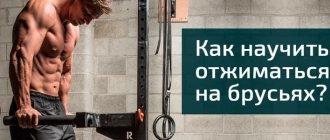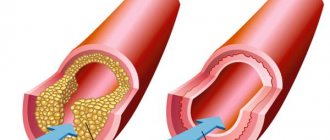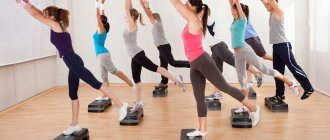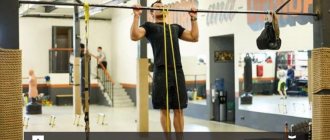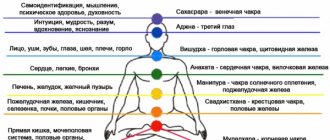SPORTS GYMNASTICS
(Greek gymnastike, from gymnazo - I exercise, train), one of the oldest sports, including competitions on various gymnastic apparatus, as well as in floor exercises and vaults.
Currently, at international tournaments, gymnasts compete for 14 sets of awards: two in the team competition (men and women), two in the absolute individual championship (men and women) and ten in individual all-around events (4 for women, 6 for men). Also on the topic:
OLYMPIC GAMES OF ANCIENT GREECE
In the program of the Olympic Games since 1896.
Gymnastics is the technical basis of many sports; corresponding exercises are included in the training program for representatives of a wide variety of sports disciplines. Gymnastics not only provides certain technical skills, but also develops strength, flexibility, endurance, a sense of balance, and coordination of movements. see also
DIVING.
Gymnastics competition program
Exercises on parallel bars
. There are parallel bars (men) and uneven bars (women). The apparatus consists of two oval (in cross-section) wooden poles mounted on a metal frame: for men - at a height of 1.75 m, for women - 1.65 and 2.45 m. (The height of all gymnastic apparatus is measured from the surface located near them safety mats).
Women's parallel bars exercises include, first of all, rotations in both directions around the top and bottom poles, as well as various technical elements performed above and below them with rotation around the longitudinal and transverse axis using a one- and two-handed grip (as well as without using hands ).
Men's parallel bars exercises combine dynamic (rotations, swing movements, etc.) and static (horizontal supports, handstands) elements. The gymnast must use the entire length of the apparatus, “working” above and below the bars.
Floor exercises (wives and men) are performed on a special gymnastics mat 12 x 12 m. There is a 1 meter wide “safety boundary” around the carpet. The carpet (wool or synthetic) has an elastic surface - dense enough for pushing, but at the same time providing athletes with a soft landing. Floor exercises are a combination of individual elements (somersaults, somersaults, splits, handstands, etc.) and their combinations, different in tempo and “mood”.
As the performance progresses, athletes must make maximum use of the entire area of the mat. The complexity of the program and its individual elements, as well as the purity and confidence of execution, are assessed. No less important is the originality of the presented composition and the artistry of the athlete - especially for women, whose performances are accompanied by musical accompaniment and include separate dance steps, which are in many ways reminiscent of exercises from rhythmic gymnastics. Performance time on the mat is limited: 1 minute 10 seconds for men and one and a half minutes for women.
Vault
(men and women). Performed from a running start using additional support (hence the name of the exercise). The length of the projectile is 1.6 m, the width is 0.35 m. The athlete runs up along a special track 25 m long and 1 m wide, pushes off with his feet from the bridge - a shock-absorbing device 20 cm high, inclined to the run-up line - and then makes an additional push hands (for men a push with one hand is allowed) from the projectile. The jumps performed can be straight, somersault, inverted, etc. For men, the apparatus is installed at a height of 1.35 m parallel to the runway, for women - at a height of 1.25 m perpendicular to the track. Another significant difference is related to the competition formula: men are given only one attempt, women – two, based on the results of which the average score for completing the exercise is calculated. The height and distance of the jump, its complexity (number of revolutions around the longitudinal and transverse axis, etc.), cleanliness of execution and precision of landing are assessed.
Balance Beam Exercises
(women) – a gymnastic apparatus 5 m long and 0.1 m wide, fixedly fixed at a height of 1.25 m from the floor. The exercise is a single composition of dynamic (jumps, turns, “jogging”, somersaults, dance steps, etc.) and static (splits, swallow, etc.) elements performed standing, sitting and lying on the apparatus. Athletes must use the entire length of the beam. The judges evaluate the gymnasts' flexibility, balance and elegance. The duration of the speech is no more than 1 minute 30 seconds.
Exercises on horseback
(male) - a special apparatus with handles that allow you to perform swinging movements with your legs. (The same apparatus, but without the handles, is used in the vault.) The horse is fixed at a height of 1.05 m. The exercises are a combination of swinging and rotational movements, as well as handstands, during which all parts of the apparatus must be used.
Ring exercises
(male) - a movable apparatus in the form of two wooden rings attached to special cables at a height of 2.55 m. Exercises on the rings (lifts, rotations and twists) demonstrate not only the flexibility, but also the physical strength of the athlete. The static elements of these exercises are no less difficult to perform than the dynamic ones. According to the rules, dismounting from the rings at the end of the performance must be an acrobatic element. As when performing exercises on the horizontal bar, when taking the starting position on the rings, the athlete can use the help of a coach or assistant.
Exercises on the horizontal bar
(male) - a polished steel bar with a diameter of 27–28 mm and a length of 2.5 m, fixed on two racks with the help of guy wires at a height of 2.55 m. According to the rules, when performing rotations (in different directions) around the crossbar, the athlete does not has the right to touch her with his body. During the performance, he must demonstrate various types of grips and the ability to move cleanly and clearly from one type to another.
The sequence of program execution is usually as follows:
– floor exercises, pommel horse exercises, rings exercises, vault, parallel bars, horizontal bar (for men);
– vault, uneven bars, beam, floor exercise (women).
Another way
Option - taking the main stance, lean forward, hands at the back below. Leaning on the floor with straight legs, bend over, grabbing your hands under your knees and smoothly roll back, touching the tips of your toes to the floor behind your head. Then roll into a sitting position.
When rolling to the side, the body is thrown out of balance in one direction (right or left). The shoulder and forearm touch the floor in succession. The roll is carried out in the opposite direction, then the starting position is taken.
There may be a roll to the side from the squat (the so-called steep roll) with the legs together or apart. Another type of it is a roll to the side, bending over (done from a lying position on your stomach or back).
The necessary insurance in this case is to stand on the side and support the person performing the approach under the thigh with one hand, and with the other under the shoulder.
Judging and scoring
The performances of the gymnasts are assessed by the main judge and eight judges who “serve” one or another apparatus.
The judges are divided into two groups. Two judges evaluate the complexity and composition of the exercise using a 10-point system, and six other judges evaluate the execution technique. To quickly record the technical elements demonstrated by the gymnast during the performance, the judges use more than 1000 special written signs - similar to shorthand.
From the score given by the first group of judges, a kind of “starting price” (this is the maximum amount of points that an athlete can receive for a performance), points are deducted for mistakes made: from 0.1 points for a small error to 0.4 points for a blunder. A fall from a projectile or onto a projectile costs 0.5 points. According to the rules, when performing a vault, as well as exercises on uneven bars, rings and the crossbar, an assistant can be located next to the apparatus to secure the athlete, but if the gymnast is forced to use his help, 0.4 points are automatically deducted from the performer. Stepping on the mat (during floor exercises) or failure to comply with the time limit for the performance is also punishable by a reduction in grade.
A group of judges assessing the complexity of the presented program gives an overall score. The judges monitoring the technique make scores independently of each other: the best and worst of them are not taken into account, and the average score is calculated from the remaining four.
For a long time, a score of 10 points was, in fact, considered only theoretically possible. In 1976, during the Montreal Olympics, the young Romanian athlete Nadia Comaneci became the first gymnast in history to achieve this in practice. Moreover, Comaneci was then awarded the highest rating 7 times.
During team competitions and during the overall championship, the scores received by a team or an individual athlete in various types of programs are summed up. Based on them, the final grade is derived. The gymnast or team with the most points is declared the winner.
The team competition uses a 6-5-4 scheme. No more than 6 athletes compete for each team at competitions, 5 of them “work” on a particular apparatus, and only the 4 best results are taken into account. (Previously, the 7-6-5 scheme was in effect.)
In team competitions, as well as during individual championships (absolute and in certain types of the program), the athlete is given only one attempt on each apparatus. The exception is vault among women ( see above
).
Competitors themselves determine the “content” of their exercises on a particular apparatus, but their performance must meet existing requirements regarding the type and complexity of the technical elements used.
Each exercise has a beginning, a main part and an ending (dismount).
Basic elements
Let's consider the basic elements of such strength training:
Aerobic - one approach involves a certain number of movements of the same nature.
Anaerobic is a type of training based on the principle - the greater the load, the fewer repetitions required. At the same time, small but long-term loads develop the athlete’s endurance, and large loads achieve the growth of muscle fibers.
A special place in the exercises of this sport is given to movements with extreme tension of certain muscle groups, which the gymnast performs in static tension mode (caution, dangerous for the cardiovascular system). These are the elements that increase the effectiveness of strength training.
The training consists of three stages:
- Warm-up
- Basic exercises
- Final part.
Warm-up usually takes a few minutes and consists of movements to warm up the muscles. During the warm-up, they run, do push-ups, jump rope, and perform muscle stretching exercises.
The main part consists of strength exercises selected taking into account the athlete’s level of fitness.
The final movements are aimed at gradually relaxing the muscles, usually walking or swimming.
Competition formula, determination of the winner
Major international artistic gymnastics competitions consist of four stages:
– Qualifying (or preliminary) stage among individual gymnasts and teams, based on the results of which the composition of the finalists is determined;
– The team final is held among the 6 strongest teams based on the results of “qualification” (separately among men and among women);
– The absolute championship in the individual competition is played out among the 36 best athletes;
– The championship in individual events is played out by 8 athletes who showed the best results in certain exercises at the preliminary stage.
At large competitions, as a rule, six men's or four women's teams (according to the number of apparatuses) perform simultaneously on the platform. Having completed the performance in one type of program, the team moves on to the next.
The Olympic Games, unlike the World Championships, are limited to a limited number of participants. These are 12 men's and 12 women's national teams that showed the best results at the World Championships preceding the Olympics. The total number of individuals participating in the Olympic gymnastics tournament is 98 (for both men and women). In addition to the athletes of the 12 best teams, they include representatives of countries that took places at the championship from 13th and below, as well as a number of athletes selected by the International Gymnastics Federation (FIG) on an individual basis.
According to the rules, no more than 3 representatives of one country can participate in the final part of the competition for the title of absolute champion of the Olympic Games, and no more than 2 in the championship competition in individual exercises.
Since 1997, the program of the World Gymnastics Championships and the Olympic Gymnastics Tournament no longer includes compulsory exercises. The compulsory and free programs, the results of which previously determined the winning teams and the composition of the final participants in the individual competition, have been replaced by a qualifying stage among gymnasts and a team final.
Competitive method
The competitive method is a way of performing exercises in the form of competitions. The essence of the method is to use competitions as a means of increasing the level of preparedness of students. A prerequisite for the competitive method is the preparedness of those involved in performing the exercises in which they must compete.
In the practice of physical education, the competitive method is manifested:
1) in the form of official competitions at various levels (Olympic Games, world championships in various sports, national and city championships, qualifying competitions, etc.);
2) as an element of organizing a lesson, any physical education and sports activity, including sports training.
The competitive method allows:
- stimulate maximum manifestation of motor abilities and identify the level of their development;
- identify and evaluate the quality of mastery of motor actions;
- provide maximum physical activity;
- promote the development of strong-willed qualities.
Some other rules
Gymnastics is one of those sports that has undergone an intensive process of “rejuvenation” in recent decades. A kind of record was set in 1987 by the Romanian gymnast Aurelia Dobre, who won the title of absolute world champion at the age of less than 15. Even younger was her compatriot Daniela Silivas, who two years earlier received a gold medal at the World Championships for winning the balance beam exercise. Currently, the minimum age for participants in major international gymnastics tournaments is not 15, as before, but 16 years old (the same age athletes must turn in the year of the competition).
There are also some “procedural” restrictions in modern artistic gymnastics:
– the transition from projectile to projectile is carried out in an organized manner;
– competition participants are given 30–40 seconds to warm up, after which they are called to perform the exercise;
– during the execution of the program, the coach has no right to talk to the gymnast;
– during the competition, participants do not have the right to leave the site without special permission.
The rules provide for penalties for individual gymnasts and entire teams: for example, for failure to appear for warm-ups. Unsportsmanlike (and undisciplined) behavior of athletes is punishable by a fine.
Failure to comply with the dress code can also affect the results of a gymnast’s performance. The first remark entails a deduction of points – and up to and including removal from the competition in the overall classification.
When performing exercises on apparatus, it is allowed to use special leather pads for the palms to avoid damage.
About technology
The basis of gymnastic technique is certain body positions on the apparatus and movements performed during the exercise.
Vis
– a position in which the athlete’s shoulders are below the grip point, and the emphasis is when they are located above the fulcrum. The emphasis can be carried out with the arms, legs or torso.
Grip –
a certain way of holding the gymnast on the apparatus. There are grips: from above, from below, from the outside, a reverse grip of the hands on the inside of the projectile, mixed, cross, long and narrow (closed).
Grouping –
a position in which the body is bent as much as possible at the waist, knees joined together are pressed to the chest, and hands clasp the lower part of the legs.
Corner -
body position (hanging or supporting) when the outstretched legs are located at right angles to the body.
Leg-split -
body position in which the legs are maximally spread.
Transition
– movement of the athlete on the apparatus to the right or left when performing any technical element.
Climb
– transition from hanging to support or from a lower support to a higher one.
Flight
– movement of the gymnast (from hanging or support) from one side (part) of the apparatus to the other.
Circle -
circular motion over a projectile or part of it.
Turnover –
circular rotational movement of the athlete around the axis of the apparatus or grip points.
Twist
– performing the exercise with a rotational movement in the shoulder joints.
Max
(forward, backward or to the side)
-
a pendulum-like movement of the body from one extreme point to another.
There are also swinging -
a similar movement of some parts of the body relative to others (at emphasis) or the whole body near the grip points (while hanging),
swing -
movement of the leg (legs) above the projectile (at emphasis) or under it (while hanging) and
crossing -
two swings performed simultaneously towards each other.
Rotate –
the movement of the gymnast’s body around its longitudinal axis or the movement of individual parts of the body around their longitudinal axes.
Coup –
rotational movement of the body with turning over the head forward or backward.
Somersault –
a complete flip over the head in the air (without support) from a standstill, from a run and when flying from one part of the projectile to another.
Dismount –
jumping from the apparatus to the floor in various ways at the end of the exercise.
Individual gymnastic apparatus have their own specific positions and movements. For example, in exercises on rings a cross
(support with arms spread to the sides) and
swing
(single movement of the body together with the projectile in one direction).
In the technical arsenal of gymnasts there are many “combined” elements (for example, inversion lift)
, as well as more complex variations of basic movements - like a back flip with a 360-degree turn.
Many outstanding gymnasts come up with their own technical elements, which then receive their names: “Delasal circles” on the pommel horse, “Diomidov’s spinner” on the uneven bars, high bar dismount and “Tsukahara” vault, “Korbut loop” on the uneven bars and “Korbut somersault” on the balance beam , exercise on the crossbar “Delchev”, “Azaryan cross” on rings, etc.
Rack
This is the name of an acrobatic exercise in which the body assumes a vertical position with its legs up in support. This is a type of limited equilibrium. There may be different categories of difficulty. The emphasis is on the shoulders, shoulder blades, arms, head, etc.
The main option is a stand on the shoulder blades. The support is on the back of the head, neck, elbows and shoulder blades with support for the lower back. At the same time, the coach belays the leg from the side.
A handstand and headstand (at the same time) are performed from a crouched position or a sitting position on the heels, as well as from other positions.
Handstands are difficult to perform due to the need to maintain balance and are often accompanied by falling backwards or forwards. Balance is achieved by pressing your fingers or palms onto the floor. This stance can be performed with a swing or a push of the legs.
When performing it, belaying by holding the shin and thigh is strictly required. When falling, the performer himself must rearrange his arms or lower his leg so as not to hurt himself.
Gymnastics in antiquity and the Middle Ages
Gymnastics as a sport and an integral system of physical education originated in Ancient Greece. Homer, Aristotle and Plato wrote and spoke about the beneficial effects of regular gymnastics on the harmonious development of the individual. In addition to the general developmental and special exercises that are familiar to us, the gymnastics of the ancient Greeks included swimming, running, wrestling, boxing, riding (horseback and chariot riding), etc. According to one version, the word “gymnastics” itself comes from the Greek “gumnos” (naked): as you know, ancient Greek athletes competed without clothes.
Early Christians considered gymnastics a “satanic invention,” opposing the carnal, i.e. its “sinful” beginning - which, first of all, meant the nakedness of athletes - - spiritual, sublime. In 393, gymnastics was officially banned.
In ancient times, not only the Greeks were familiar with gymnastics. For example, in China and India several thousand years ago, gymnastic exercises were also practiced - mainly for medicinal purposes. Even then, special devices were known, similar to some modern gymnastic apparatus. Thus, in ancient Rome, to teach the basics of horse riding, a certain semblance of the “horse” known to us was used.
With the beginning of the European Renaissance, interest in gymnastics of the ancient Greeks reawakened: Renaissance thinkers perceived it as a means of strengthening health and general physical development of a person. The theoretical foundations of the physical education system are gradually being laid (Rousseau, Pestalozzi, etc.). The immediate predecessor of modern artistic gymnastics in the 16th–17th centuries. Vaulting (exercises and jumps) on a table and a horse, climbing a pole and a wall, maintaining balance on a rope and trees became very popular at that time.
Classification of acrobatic exercises
There are three main groups. The first is acrobatic jumps: rolls, somersaults, flips. The second is balancing. This includes shoulder stands, shoulder stands, and handstands (including one-arm stands). There are also exercises in pairs and groups. Typically, acrobats form pyramids, the number of participants of which is from three people.
The third group includes throwing movements. What are they? The name speaks for itself - this is a toss of a partner with a transition to the shoulder or hands (with a grip on the thigh, lower leg, foot or hand) or landing.
Good preparation of this type is necessary when performing exercises on gymnastic apparatus.
The secondary school physical education program also includes acrobatics. During the lessons, children learn to perform somersaults, rolls, various stances, bridges and much more. This allows them to better own and control their own body. Acrobatics helps to develop physically and overcome fears, and develops willpower.
The origin and development of modern artistic gymnastics
In the XVIII - early XIX centuries. In Germany, a physical education system was being formed, which was based on gymnastics. The founder of the German gymnastics movement was F.L. Jan. He significantly expanded the “gymnastic field” and invented new exercises and apparatus (including the horizontal bar and parallel bars), thereby laying the foundations of modern artistic gymnastics. In 1811, Jan opened the first gymnastics ground (near Berlin), and five years later he published - together with one of his students E. Eiselen - the book German Gymnastics
: it contained descriptions of the basic exercises and the necessary methodological recommendations. The first public performances of gymnasts date back to approximately this time.
Their own systems of physical education were developed in the Czech Republic, Sweden and France, and a little later – in Russia. During this period, exercises on apparatus and vaults were cultivated. Although floor exercises in one form or another were known several centuries ago (for example, from the performances of traveling circus troupes, which demonstrated, among other things, unusual acts on the floor or on the ground), they did not immediately gain recognition as one of the gymnastic disciplines.
In its development, artistic gymnastics went through several stages: over time, the requirements for it and, accordingly, its content changed. History of gymnastics in the 19th century. was largely determined by the confrontation between two fundamentally different systems: the Swedish, in which the emphasis was primarily on floor exercises (in a broad sense), and the German, which gravitated towards apparatus exercises.
In the middle of the century, the first indoor gymnasiums appeared in Germany (before that, only open areas operated). Official competitions in artistic gymnastics begin. In the second half of the 19th century. Europe, and later America, are experiencing a real gymnastics boom.
And the next century can rightfully be called the “century of gymnastics.” Although the modern program of gymnastic competitions was not immediately determined. Moreover, they took place in an unusual way. Gymnast competitions were often held outdoors. At first, there were no uniform technical requirements for gymnastic equipment: often national teams came to international competitions with their own “props”.
Before World War II, gymnasts from Germany, Czechoslovakia, France, Italy, Switzerland, Finland, the USA, Yugoslavia, and Hungary performed more successfully than others. In the 50s, the world gymnastic elite included athletes from the USSR and Japan, later from Romania, China and Bulgaria, and with the collapse of the USSR - representatives from Russia, Ukraine and Belarus.
International Gymnastics Federation
In 1881, the European Gymnastics Federation (EGF) was created, which initially included only three countries: Belgium, France and the Netherlands. The founder and first president of the Federation was the Belgian Nicholas Couperus. In 1921, with the appearance of the first non-European countries in the FEG, it was reorganized into the International Gymnastics Federation (FIG), which now unites artistic gymnastics and related disciplines: general gymnastics, rhythmic gymnastics, trampolining, sports aerobics and acrobatics.
FIG is the oldest international sports association. And one of the most numerous: as of January 2002, the Federation consisted of 125 countries. More than 30 million people now practice gymnastics in various clubs around the world. A total of about 2,500 masters participate in world and continental championships.
European Gymnastics Union
It is interesting that the European Championship in artistic gymnastics began to be played long before the corresponding governing body appeared in the Old World. In 1955, the first European Championships among male gymnasts took place. Two years later, women also entered the fight for European gold. Until the mid-1980s, the European Championships were held under the auspices of the FIG, with competitions for men and women taking place at different times and in different countries.
In 1982, the European Gymnastics Union (UEG) was created. The 1986 European Championship in Germany was the first that the Union organized and held independently - without the help of the International Federation (in the same year the USSR joined the UEJ).
Currently, the Union includes 46 countries. UEJ is one of the most numerous and active sports associations on the continent. In addition to the championship, the European Cup is played, and many other competitions (for different age groups), festivals and other events related to artistic gymnastics are held.
The most titled “European” among gymnasts is Yugoslav Miroslav Cerar, who twice won the title of absolute champion of the continent and won a total of 21 medals (including 9 gold).
World Championship
Since 1903, an international artistic gymnastics tournament began to be held regularly, and in the 1930s it received the status of a world championship. (Georges Martinez from France, who won the 1903 tournament, thus became the first absolute world champion in gymnastics in history). The world championship, held in 1931 in Paris, was dedicated to the 50th anniversary of the FIG and was considered unofficial. The tournament, held three years later in Budapest, continued its overall numbering and went down in history as the 10th World Artistic Gymnastics Championships. (It was at this championship that women competed for the first time in the world championship.) The next world championship, starting in 2003 in the USA, is already the 37th in a row.
From 1903 to 1930, world tournaments were held every other year, from 1934 to 1978 - once every four years (during the First and Second World Wars, competitions were not held), then the organizers returned to the previous pattern.
In the early 90s, another change was made to the world championship formula. Along with competitions in which all 14 sets of awards are played out (as was the case, for example, in 1999 and 2001), tournaments are held according to a “truncated” program: for example, in 2002, championships were played out only in certain types of the program. In the “Olympic” year, world championships are not held at all.
The program of the World Artistic Gymnastics Championships did not immediately take on its usual “look”. Until 1954, it also included individual athletics disciplines.
The USSR women's team took first place at the World Championships 11 times, the men's team 8 times.
Champion or health
The most important choice, because professional sports and health are not very compatible things. Most professional schools, which make it a priority to develop champions and prize-winners of world tournaments, conduct strict selection, it is difficult to get there, the training is tough and exhausting physically and emotionally.
Along with such sports schools, there are also general development schools, where they do not choose stars, pay attention to the harmonious development and improvement of the health of children, do not torture them with exhausting training, but they do not put them on a world gymnastics pedestal.
The cost of classes is much higher, since they are held in groups of several people, and group leaders may require individual training with a star trainer. Constant trips to training camps and competitions, costumes and sports equipment require large investments.
world Cup
Among all international competitions in artistic gymnastics, the World Cup is considered the third most important - after the world championship and the Olympic Games.
It was first played in 1975 in England. The winners then were Soviet gymnasts Nikolai Andrianov and Lyudmila Turishcheva. Until 1990, Cup competitions took place in years when neither the Olympic Games nor the World Gymnastics Championships were held. During this time, the Cup was played 8 times - in the absolute individual championship. The advantage of the USSR gymnasts was overwhelming. For women, all eight titles were won by our athletes: in addition to Turishcheva, similar success was achieved by M. Filatova and S. Zakharova (twice each), E. Shushunova and T. Lysenko. In 1982 O. Bicherova and N. Yurchenko shared first place. For men, N. Andrianov and A. Dityatin (both twice), M. Bogdan and V. Belenky became the winners of the World Cup in different years. The only foreign athlete who managed to break the “Soviet hegemony” in the Cup was the Chinese Li Ning in the mid-80s (he shared his second title with our Yu. Korolev).
Due to changes in the formula for holding world championships in the early 90s, it was decided not to play the World Cup anymore. But 8 years later, the honorary trophy was “reborn” again. True, now the competition participants are challenging the championship in certain types of gymnastic all-around. At the 1998 World Cup in Japan, the strongest performers were the representatives of China and Romania, who won 4 and 3 first places, respectively. Romanian athletes also performed successfully at the 2000 World Cup in Scotland - primarily thanks to the leader of their women's national gymnastics in recent years, 3-time all-around world champion Andrea Raducan.
Currently, the Cup is played according to a new scheme: in 2001–2002, a series of tournaments were held in different countries.
Gymnastics at the Olympics
Artistic gymnastics is invariably included in the program of the Olympic Games, occupying one of the central places in it.
True, the gymnastics program of the very first Modern Games (1896) was somewhat different from the current Olympics. 18 gymnasts, representing 5 countries in Athens, competed in individual all-around events: not only in the usual exercises (with the exception of floor), but also in group exercises on parallel bars and horizontal bar and in rope climbing. The dominance of the founders of gymnastics - the Germans - in all types of programs was almost undivided.
The first absolute champion of the Olympic Games in artistic gymnastics was the Frenchman Gustave Sandra in 1900. The championship among teams and in individual all-around events was not competed for at the Paris Olympics.
At the 1904 Games, another unusual discipline appeared in the competition program among gymnasts: exercises with clubs. As you know, the overwhelming majority of participants in the St. Louis Olympics represented the United States. So the unconditional success of the Americans on the gymnastics platform was quite predictable.
At the next two Olympics there was no equal to the Italian Alberto Braglia. At the 1912 Games, he also added gold to his title of absolute champion, won as part of the Italian team in the team competition.
Competitions in certain types of all-around gymnastics reappeared in the Olympic program after the First World War - at the 1924 Games.
Four years later, women competed in the Olympic gymnastics tournament for the first time. True, the gymnasts again missed the next Olympics - and only in 1936 they began to participate in them constantly. It is noteworthy that the program of the 1936 Olympic tournament in women's gymnastics also included exercises on parallel bars. And at the 1948 Olympics, women performed mandatory ring exercises. At one time, the program of the Olympic tournament in women's gymnastics also included group exercises with various objects (mace, ball, etc.), which later became an integral part of rhythmic gymnastics. At the 1952 Games, a significant change was made to the competition formula in women's gymnastics: for the first time, athletes competed in the individual competition (on four apparatus). In its current form, the Olympic program for women's gymnastics was finally determined in 1960 (Men have competed for awards according to the 6+1+1 scheme since 1936).
In the team competition in the history of Olympic gymnastics tournaments, there was and is no equal to the USSR women's team, which has risen to the highest step of the podium 10 times. Among men, the teams of the USSR and Japan won more often than others - 5 times each. The Italian men's team celebrated victory four times - although this was before the Second World War.
The title of absolute Olympic champion is considered the highest title in artistic gymnastics. The outstanding Soviet gymnast Larisa Latynina achieved a unique achievement. Her collection includes 18 Olympic medals (of which 9 are gold: 6 received in individual and 3 in team competitions). None of the Olympians have yet managed to repeat, or even surpass, this record. Czech gymnast Vera Caslavska (Odlozhikova) won 7 gold medals (all in the individual competition). The same amount of “gold” (as well as 5 silver and 3 bronze medals) in Nikolai Andrianov’s collection of awards. (Andrianov and Latynina are the two most titled athletes in the history of world gymnastics.) Another of our gymnasts, Alexander Dityatin, set another unique record at the 1980 Olympics, winning 8 out of 8 possible awards: in the team event, in the “absolute” and in individual all-around events (3 gold, 4 silver and 1 bronze medals).
Vitaly Shcherbo completed the “Soviet era” in Olympic gymnastics with dignity: performing at the 1992 Games as part of the united team of the CIS countries, he won 6 gold medals.
Gymnastics in pre-revolutionary Russia
Various gymnastic exercises were known back in ancient Rus' - as an integral part of folk holidays.
The widespread development of gymnastics in Russia began in the 18th century. Peter I and A.V. Suvorov paid serious attention to gymnastics as an applied discipline. Suvorov outlined the contents of the gymnastic exercises being introduced - on his initiative - into the army at the Regimental Establishment
.
As in other countries, in Russia artistic gymnastics was initially cultivated mainly in the army environment. In the 70s of the 19th century, the famous Russian scientist and teacher P.F. Lesgaft opened two-year gymnastic courses in St. Petersburg (now the Lesgaft Institute of Physical Culture). The first gymnastics competitions in our country, organized by the Russian Gymnastics Society, were held in 1885 in Moscow. Only 11 people took part in them, but a start was made.
In 1889, gymnastics was introduced into the program of men's educational institutions. At the end of the 19th and beginning of the 20th centuries, gymnastic societies and clubs were created in various cities of Russia, and national championships began to be held regularly.
In 1912, Russian gymnasts took part in the Olympic Games for the first time, but were unable to compete with more experienced opponents.
7.1. Characteristics of applied exercises
The group of applied exercises includes walking and running, balance, climbing and climbing, throwing and catching objects, lifting and carrying loads, crawling, and overcoming various obstacles. In addition to their direct application in various areas of human physical activity, these exercises are of great importance for improving strength, speed, endurance and agility.
Thanks to the relatively simple motor structure, applied exercises are accessible to any group of students. Some of these exercises are a good corrective tool for correcting a number of physical deficiencies, so it is no coincidence that applied exercises occupy a significant place in physical education programs for schoolchildren and students.
In the physical training of soldiers of the Soviet Army, this group of exercises is considered the most important. Applied exercises are recognized as an effective means of professional applied training. 69
69
I Applied exercises are also valuable because they can be performed in a natural environment, using various objects; Equipment for training places is not complicated or expensive. During active rest, applied exercises, along with other means, can be successfully used by athletes of the highest qualifications. Applied exercises can be included in all parts of the lesson, and training in basic exercises is carried out in the main part. The final part of any gymnastics lesson, the main task of which is to create conditions for the occurrence of recovery processes in the bodies of those involved, is unthinkable without such an exercise as walking.
Gymnastics in the USSR
In the USSR, gymnastics became a truly mass sport, although at first the attitude towards this “relic of the bourgeois past” was wary, and even hostile.
The development of artistic gymnastics in the USSR in the 20s is associated, first of all, with the implementation of universal education. The first national championship was held in 1928 (as part of the All-Union Spartakiad). The Ukrainian team won the team competition, and Mechislav Murashko became the absolute champion of the country. The program of the first gymnastics competitions included not only the “classical” disciplines, but also running, rope climbing, grenade throwing and other applied exercises.
In the early 30s, the All-Union Gymnastics Section was created, later transformed into the USSR Artistic Gymnastics Federation. In 1932, the second absolute championship of the country was played - this time women also took part in the competition. The first absolute champion was Tatyana Voshchinina. And since 1939, awards in certain types of programs also began to be awarded at national championships.
The debut of Soviet gymnasts on the international stage took place in 1937 - at the 3rd Workers' Olympics in Antwerp. Our men's and women's teams won the team championship, and Nikolai Sery and Maria Tyshko won the title of absolute champions.
In 1949, the USSR Gymnastics Federation joined the FIG. And in 1952, Soviet gymnasts participated in the Olympic Games for the first time. The debut turned out to be successful: our athletes became champions in both the team (men's and women's teams) and individual (Viktor Chukarin and Maria Gorokhovskaya) competitions. The debut of Soviet gymnasts at the world championship two years later was equally convincing: victories in team competitions and titles of absolute world champions for men (Viktor Chukarin and Valentin Muratov) and women (Galina Rudko (Shamray)).
In total, Soviet gymnasts won more than 300 awards at the Olympic Games: about half of them were gold. And at the 14 world championships that took place with their participation, our athletes won more than 400 medals, including quite a few golds.
The Soviet school of gymnastics gave the world many outstanding athletes: Larisa Latynina, Lyudmila Turishcheva, Boris Shakhlin, Viktor Chukarin, Mikhail Voronin, Yuri Titov, Valentin and Sofia Muratov, Natalya Kuchinskaya, Polina Astakhova, Yuri Titov, Nikolai Andrianov, Olga Korbut, Alexander Dityatin, Yuri Korolev, Nelly Kim, Vitaly Shcherbo, Elena Shushunova, Dmitry Bilozerchev, Elena Mukhina, Olga Bicherova and many others. etc.
Indications
For recreational gymnastics, the doctor determines the indications. You should not decide to perform narrowly targeted exercises on your own. This can lead to disproportionate development of the child, causing more harm.
Among the factors that may contribute to the decision to send a child to the gymnastics section may be the child’s personal desire to become an outstanding athlete, minor posture disorders (only after consultation with a specialist), the parents’ desire to improve the child’s physical characteristics, strengthen character, discipline, develop willpower, make the child is more artistic, more emotional and more self-confident.
Russian gymnastics today
The Russian Artistic Gymnastics Federation was founded in 1991. It unites organizations from 71 constituent entities of the Russian Federation. The Federation is headed by Professor L.Ya. Arkaev, who is also the head coach of the Russian national gymnastics team. Russia regularly hosts national championships, regional, all-Russian and international tournaments and other events. The Federation is part of the FIG and UEJ.
The current “stars” of domestic gymnastics continue the victorious relay of their predecessors in the international arena. A. Nemov became the absolute champion of the Olympic Games in Sydney 2000, and also won gold in the horizontal bar exercises. S. Khorkina is the absolute world champion (twice) and Europe (three times), her collection also includes Olympic and world “gold” on individual apparatus. N. Kryukov is the absolute world champion, A. Bondarenko is the absolute European champion. E. Zamolodchikova is the winner (in certain types of programs) of the World Championships and the Olympic Games.
According to data at the end of 2002, A. Nemov and S. Khorkina headed the world gymnastics ranking.
K.Petrov
